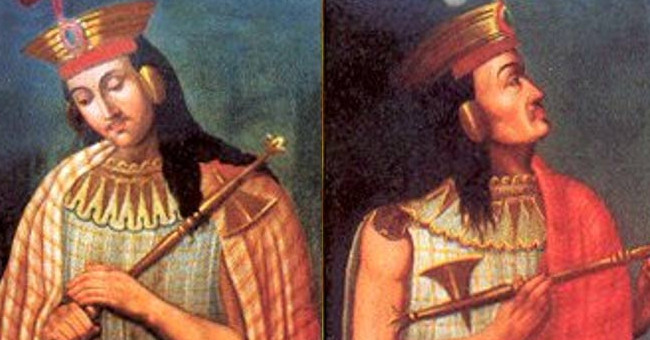Fraternity is similar to the collapse of the Inca empire
The war between the two princes ended not with the unification of the Inca empire under a king but with the invasion of the Spaniards.
The cause of the Inca Empire collapsed
On July 26, 1533, the last king of the Inca empire, Atahualpa, was hanged by the Spanish invaders. The execution marks the collapse of the once-powerful Inca empire and opened Spain's dominance in South America.
A year earlier, Atahualpa had just won the bloody civil war to win the throne. This war is known by many names such as the Inca civil war, the Inca war, the Inca battle for succession or the war between the two brothers.
According to Ancient Origins, the war between the two brothers began after the death of Emperor Huayna Capac and his successor Ninan Cuyochi in 1527. Two men were more likely to die from smallpox, a disease spread in the community. Native coins since the Spaniards set foot on the continent.
Traditionally, the emperor (called Sapa Inca), will pass the throne to the eldest. However, in the case of Huayna Capac, the eldest son Ninan Cuyochi even died before him. Soon after, Huayna Capac was also bedridden. Sapa Inca decided to break the tradition and divide the kingdom for the other two children, Huáscar and Atahualpa.

Photos of Huáscar (left) and Atahualpa (right) on Peru's stamp issued in 2004. (Photo: Stamp Peru).
Between the two, Huáscar was larger and the second child of Huayna Capac with the queen. Meanwhile, Atahualpa was born by something. Therefore, Huáscar was entitled to rule the entire Inca, except Quito and the surrounding area, located in the north of the kingdom. Ruled in Cuzco (Cusco), the capital of the Inca empire, Huáscar ruled the majority of the population.
Atahualpa commanded the Inca army, stationed in the north at that time, tasked with conquering smaller tribes at the border of the kingdom. Three excellent generals, Chalcuchima, Quisquis, and Rumiñahui, all turned to Atahualpa.
Perhaps Huayna Capac hoped that the brothers would rule the kingdom in a harmonious way. However, this is not possible because Huáscar views Atahualpa's military command as a threat to the holding position. As a result, Huáscar decided to attack first by seizing Quito.
The move seems to have succeeded at first, Huáscar's army defeated and captured Atahualpa near Tomebamba. Atahualpa sought to escape and returned to Quito to concentrate his forces. Although Huáscar tried to occupy Atahualpa's base, he still failed and was pushed south. Afterwards, Atahualpa sent a army led by Chalcuchima and the Quisquis to pursue Huáscar, while the other general was Rumiñahui, who served as Quito's guard.
After taking the throne, Huáscar became increasingly authoritarian. He killed the escort warlords of King Huayna Capac. They are all high esteemed nobles in Upper Cuzco. The nobility became even angrier when Huáscar threatened to burn royal mummies and rob their property.
Furthermore, Huáscar tortured the messenger sent by Atahualpa. According to the accusations, messengers carrying Atahualpa's gifts sent Huáscar a pinch and returned with ragged clothes. However, it is likely that allegations of Huáscar's cruelty come from Atahualpa and his supporters.
In 1532, Atahualpa's army finally defeated Huáscar in a decisive battle outside Cuzco, and Sapa Inca was arrested as a prisoner. News of the victory passed to Atahualpa at that time in the city of Cajamarca.
At the same time, information about strange white men with "facial hair" (only Spaniards) was also reported. Atahualpa did not know his short reign, the white men would invade the Inca empire and force him to die.
- The girl's remains revealed the terrifying power of the Inca empire
- Discovered the unexpected cause of the collapse of the ancient Roman empire
- The Incas saw gold as the sweat of the Sun God
- The great trail of the Inca empire
- The mystery of 'transcontinental highway' is 40,000km long since ancient times
- New discoveries in Peru reveal the possibility of the Inca skull surgery
- Behind the fall of the Maya empire
- A century of wondrous discoveries Machu Picchu
- Discovered collective grave of Inca civilization in Peru
- Dust can also cause a mighty empire to collapse
- Inca trail
- Why was the Roman empire destroyed? (Part I)
 Biography of hero Vu A Dinh
Biography of hero Vu A Dinh History of hematology
History of hematology Who is Mr. Tam Da 'Phuc-Loc-Tho' and what does it mean?
Who is Mr. Tam Da 'Phuc-Loc-Tho' and what does it mean? Unbelievable facts about the history of the oil and gas industry: Gasoline used to be cheaper than water, so abundant that it had to be dumped into the river...
Unbelievable facts about the history of the oil and gas industry: Gasoline used to be cheaper than water, so abundant that it had to be dumped into the river...